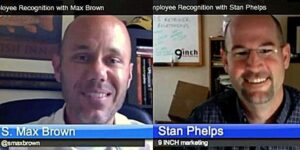
Why Manager Feedback is the Best Form of Workforce Planning
Sponsored by The Culture Platform “Get some perspective.” That’s the best advice I ever received as a manager. And I took it to heart, because during

Sponsored by The Culture Platform “Get some perspective.” That’s the best advice I ever received as a manager. And I took it to heart, because during

The pandemic was a powerful force that profoundly changed the nature of work. When lockdowns eventually lifted and organizations welcomed people back to the office,

Driven by an ever-growing desire for personalized, convenient, seamlessly integrated experiences, customer expectations continue to evolve at breakneck speed. To meet these expectations, organizations must

People often assume happy employees are also engaged. But is that really a safe bet? Sometimes with the best intentions to improve happiness in the

If you lead a business of any kind, it’s essential to understand the factors that influence employee satisfaction in your organization. This kind of insight

Without a doubt, employee surveys are the most widely used employee engagement tool. Surveys make it possible for employers to gather workforce feedback quickly and

Employee appreciation is naturally top-of-mind for employers during the holiday season. But employees actually prefer recognition throughout the year. In fact, according to a HubSpot

When it comes to training today’s hybrid workforce, traditional content formats fizzle. Their limitations in flexibility with UI, design, integrations, and analytics can cause learning

The pandemic has thrown nearly every industry into a state of rapid-fire transformation, and that includes contact centers. Chances are, nearly everyone reading this has

Want to improve the mood in your office? Offer free food. Here’s why workplace snacks make all the difference.

Cultivating a thriving workforce allows employees to become invested in where they work, boosts morale, and helps boost the bottom line. Here’s how to do that.

Today, organizations of all sizes are experiencing a digital transformation. Irrespective of the industry or sector, the majority of businesses are implementing technology to better
Worker happiness has fallen every year for the last 25 years–in good economic times and bad. Today, over half of American workers effectively hate their

We’ve known about the importance of work environments for some time now. In a 2003 survey by Management Today, 97 percent of respondents said they
HR directors at many companies today won’t put you in the doghouse for bringing your pet to work—in fact, it’s encouraged. As far as nonfinancial
“A tired mind become a shape-shifter Everybody need a mood lifter Everybody need reverse polarity Everybody got mixed feelings About the function and the form

New research indicates that employees tend to love their employers — but don’t feel it in return. What can we do about that? The #TChat crowd weighs in

It’s no secret that workforce recognition pays. The trick is getting recognition right. How can employers make it count? That’s the focus in the TalentCulture community at this week’s events…

World-class employers work overtime to create an environment that attracts new talent and keeps existing employees on board. What can the rest of us learn from them? Ask yourself 4 questions…
Sometimes we find zen. A moment of harmonic convergence in our lives when all things family, friends, co-workers, employers, work and life become one. Sometimes.
What would you do if employee turnover was nearly 100%? Would you dismiss it? Or would you want to investigate and find ways to turn that trend around? Here’s a detailed framework for making that happen…
What is Gen Y really looking for from employers? Advice for HR and organizational development professionals…